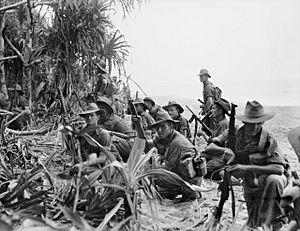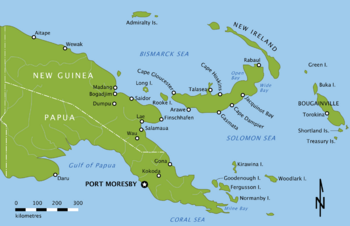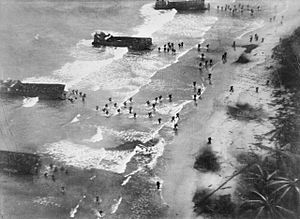Aitape–Wewak campaign facts for kids
Quick facts for kids Aitape–Wewak campaign |
|||||||
|---|---|---|---|---|---|---|---|
| Part of World War II, Pacific War | |||||||
 Australian infantrymen resting on a river bank before attacking Japanese positions near Matapau in January 1945 |
|||||||
|
|||||||
| Belligerents | |||||||
| Commanders and leaders | |||||||
| Strength | |||||||
| ~13,000 men | ~30,000–35,000 | ||||||
| Casualties and losses | |||||||
|
|
||||||
The Aitape–Wewak campaign was one of the last big battles of World War II in the Pacific Ocean. It happened between November 1944 and August 1945. Australian soldiers, with help from planes and ships, fought against the Japanese army in northern New Guinea.
The Australians saw this as a "clean-up" mission. They wanted to push the Japanese out of coastal areas and into the jungle. Even though they won, many soldiers got sick or were hurt. This made some people wonder if the battle was really needed, especially since Japan was close to losing the war.
Why the Battle Started
In 1942, Japanese forces took over the Aitape area in northern New Guinea. This was part of their plan to expand south. By 1943 and 1944, the Allies (like the US and Australia) started fighting back. They wanted to weaken the main Japanese base at Rabaul and move towards the Philippines.
On April 22, 1944, American soldiers landed at Aitape. They took back the area to protect their other forces fighting nearby. Aitape then became a base to support the push towards the Philippines. More US troops arrived there.
Most of these American soldiers stayed in a small defensive area. There wasn't much fighting, except for the Battle of Driniumor River in July. As plans for the Philippines continued, it was decided that Australian forces would take over Aitape. This would free up the American troops for other battles.
So, in October 1944, Australian soldiers from the 6th Division arrived in Aitape. They took over from the Americans. The first Australian unit started patrolling right away.
The Japanese army in Aitape had about 30,000 to 35,000 soldiers. This group had already suffered heavy losses in earlier battles. Australian planners believed the Japanese forces were much weaker than their original numbers. The Japanese had no air or naval support. Many of their soldiers were sick and didn't have enough food. Supplies only came rarely by plane or submarine.
In contrast, the Australians had better equipment, more food, and excellent medical care. They also had air support from the RAAF. This included Beaufort bombers and Boomerang and Wirraway planes for scouting. Australian navy ships also helped, supporting landings and bombardments.
The Fighting Begins
After their defeat in July, the Japanese commander, General Hatazō Adachi, pulled his troops back. During this quiet time, Japanese soldiers searched for food in the Torricelli Mountains and around Wewak. Many became sick or starved. There was little contact between the Japanese and American forces. The Americans mostly stayed on defense. The Japanese, low on supplies, also tried to avoid fights.
But when the Australians arrived, their commander, Major General Jack Stevens, decided to attack. He wanted to clear the Japanese from the coast. The Australian plan was to defend Aitape's port and airfield first. Then, they would advance towards Wewak to destroy the remaining Japanese army.
The main Australian attack began in November 1944. It moved in two directions. One group, the 19th Brigade, moved along the coast towards Wewak. Another group, the 2/6th Cavalry Commando Regiment, went into the Torricelli Mountains. They headed towards Maprik, where the Japanese got most of their supplies. While these attacks happened, other Australian brigades built defenses or stayed in reserve.
On December 19, the 19th Brigade crossed the Danmap River. They moved east to cut off Japanese supply lines. There were many small battles, but no huge fights. After four weeks, the Australians reached Wallum, about 72 kilometers (45 miles) east of Aitape. A week later, on January 24, 1945, a new brigade took over the advance. Another brigade continued moving through the Torricelli Mountains.
The fighting involved many small patrols and company-sized attacks. Moving supplies was hard because of the jungle and rivers. Rivers would suddenly flood after heavy rain. In one case, seven Australian soldiers drowned in the Danmap River. After the Australians took Dogreto Bay, getting supplies became a bit easier.
On March 16, 1945, the airfields at But and Dagua on the coast were captured. But fighting continued inland as Australians tried to take Tokuku Pass. On March 25, Lieutenant Albert Chowne led an attack on a Japanese position. He was given the Victoria Cross (a very brave award) after he died in action. Heavy fighting continued for four days. The Australians used flamethrowers for the first time in this war. These weapons were very effective and scared the Japanese.
In the Torricelli Mountains, the 17th Brigade kept pushing forward. The Japanese fought hard to defend their positions. But by April 23, 1945, the Australians had secured Maprik. After Maprik fell, the Australians built an airfield nearby. This airfield was finished on May 14, allowing more soldiers and supplies to arrive by air.
Meanwhile, the 19th Brigade began its attack on Wewak in early May. Australian and British navy ships, along with the RAAF, bombed the Japanese defenses in Wewak. On May 11, a special force landed at Dove Bay. Their goal was to surround Wewak and stop the Japanese from escaping. Wewak fell on the same day, and the 19th Brigade took its airfield. Fighting around the Wewak Airfield continued until May 15. During this time, Private Edward Kenna showed great bravery attacking Japanese bunkers. He was also awarded the Victoria Cross.
After this, the remaining Japanese soldiers moved into the Prince Alexander Mountains. Australian brigades followed them, pushing them towards other Australian forces. Meanwhile, the 19th Brigade faced strong Japanese defenses around mountains like Mount Kawakubo. This fighting lasted through June and July. These operations continued until August 11. At this point, news arrived that Japan was discussing surrender. So, all attacks were stopped.
What Happened After
By the end of the campaign, 442 Australian soldiers had died in battle. Another 145 died from other causes, like disease. Over 1,100 were wounded. A huge number, 16,203 soldiers, got sick. Many suffered from a type of malaria that was hard to treat.
For the Japanese, between 7,000 and 9,000 soldiers were killed in action. About 269 were captured during the fighting. After the war ended in New Guinea, around 13,000 Japanese soldiers surrendered. Sadly, about 14,000 had died from starvation and illness during the whole campaign.
After the war, some people questioned if this campaign was really necessary. They argued that the Japanese forces in Aitape–Wewak were not a threat to the Allies. They could have been left alone to run out of supplies. Because of this, the campaign is sometimes called an "unnecessary campaign."
However, when the battle was planned, no one knew when the war would end. There were also political reasons for Australia to fight. By late 1944, Australia's army had a smaller role in the war. The government wanted to show that Australia was still doing its part. Also, New Guinea was Australian territory. So, it was seen as a duty to clear the Japanese from the area.




